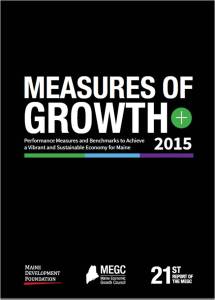20 Apr “We are here intentionally.”

The 2015 edition of Measures of Growth produced by the Maine Economic Growth Council has been released. The report is a snapshot of the state’s economic trends including the risks and rewards of living or doing business in Maine. Everyone who claims Maine as their home or as a suitable place for investment should pay attention and act accordingly. So how are we really doing? Not great using the indicators of the Growth Council.
The analysis indicated Maine made progress toward benchmarks in four categories, lost ground in seven and remained unchanged in twelve. What does the Growth Council measure and what’s the significance?
According to the introduction of this Maine Development Foundation publication, “The indicators represent the specific areas the Council believes are most relevant to Maine’s longterm economic growth. Each indicator is assigned a benchmark that is aspirational and potentially attainable, and our progress is measured against these benchmarks. Based on the judgment of the Council, Maine is compared to itself over time or to U.S., New England, or Experimental Program to Stimulate Competitive Research (EPSCoR) averages. The EPSCoR program focuses on 28 mostly large and rural states, including Maine, and offers a helpful comparison in assessing Maine’s performance.”
When data from the previous year or period of measurement is aggregated, the economic drivers of the state’s health can be expressed by these general indices:
| MEASURE | STATUS |
|---|---|
| Gross Domestic | Product of Maine Declined |
| Per Capita Personal Income | Unchanged |
| Value added per Worker | Unchanged |
| Employment | Unchanged |
| Poverty | Unchanged |
GROSS DOMESTIC PRODUCT (MAINE)
The value of all goods and services sold in Maine consists of a variety economic sectors. In an ideal world, high wage and high added-value enterprises would lead the way in terms of total impact and personal income; new money coming into Maine that grows the overall economy. Fifty-two percent of the state’s economy consists of real estate development (16%), Government (14%), Healthcare/Social Assistance (12%) and Manufacturing (10%). Of these four segments, Government and Manufacturing lost ground in 2013. The sector measuring the greatest gains (but not in the top four) was Finance/Insurance (+3.8). The point being that
PERSONAL INCOME
This is a good news/bad news scenario. The good news is that personal income in Maine grew by $1,100 from 2013 to 2014. The bad news is that the region and nation grew faster, an indicator that Maine’s economy lacks the vitality of those around us. For wages to rise, Maine needs a higher percentage of the population employed. Wages are a function of demand and we are far from full employment.
VALUE ADDED PER WORKER
This measure is worth quoting directly from the report: “The value added to products by workers depends on many factors, including the makeup of our industrial base, the skills and education of our workforce, the costs associated with doing business, and our infrastructure. There is no single action we can take, no single lever we can pull, that will improve the value added of Maine workers. Maine has improved almost 13% on this measure since 2008, to an average of $88,795 of output per Maine worker in 2013. Yet this number placed Maine last among the fifty states and the District of Columbia in 2013 and was 24% below the U.S. average of $117,472 and 28% below the New England average of $123,909.”
Suffice to say, Maine has a way to go to before reaching the middle of the national pack for economic health.
Several of the measures devised by the Growth Council also received warning flags:
- Low investment in research and development
- Too few people connecting to the internet
- Fourth grade reading scores
- Too many roads in need of repair or replacement
- Growth in the obesity rate
In contrast to prior years, the Growth Council was able to award only two gold stars; they recognized the state’s environmental quality. Maine’s air quality last year improved to the point that no days were recorded as “unhealthy for sensitive groups”. Ninety-five percent of our rivers and streams met the celebrated Category 1 and 2 standards and 90 percent of lake and pond acreage were there, as well.
What does this all mean to residents in Maine?
It’s a beautiful place to live, work and play. As Alan Caron of Envision Maine often says, “We are here intentionally.” For those who choose to make Maine their home, we must reach outside our state to sell our products and services, bring new capital and profits across our borders and attract newcomers to fill the jobs that such activity will require.



